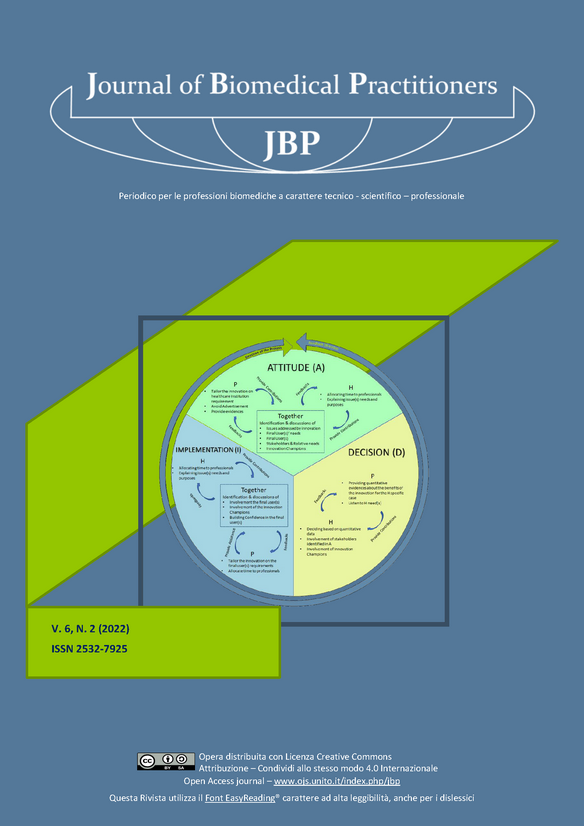Tracciabilità in anatomia patologica – raccomandazioni e buone pratiche.
Contenuto principale dell'articolo
Abstract
INTRODUZIONE
La tracciabilità in anatomia patologica è sempre più un’esigenza correlata al rischio clinico che dalla sua mancanza deriva. La linea guida della SIAPEC di maggio 2015 ne suggerisce l’applicazione nelle Anatomie Patologiche ma non ne codifica le caratteristiche per cui le aziende produttrici di software elaborano e rilasciano moduli di tracciabilità in assenza di requisiti cogenti.
METODI
Applicando la metodologia “Lean Six-Sigma” abbiamo ridisegnato il processo di anatomia patologica, individuando correttamente dove la tracciabilità possa essere il valore aggiunto sia per il paziente che per gli operatori.
OBIETTIVI
L’obiettivo dello studio è quello di analizzare con la metodologia lean i flussi dei processi di anatomia patologica da sottoporre a tracciabilità ed elaborare una best practice che ne guidi l’applicazione.
RISULTATI
La “Value Stream Map” e l’analisi dei dati raccolti hanno consentito di individuare correttamente i punti di tracciabilità (track) da implementare durante tutto il processo del campione in laboratorio a garanzia della sicurezza del processo con l’individuazione di feedback a monte (fase pre-preanalitica) ed a valle (fase post-postanalitica) di due momenti di interfaccia con l’utente esterno a garanzia dell’efficacia del processo.
DISCUSSIONE
L’inserimento di un sistema di tracciabilità all’interno dei processi di Anatomia Patologica è, soprattutto nei centri ad alta densità di attività, un’esigenza inderogabile. Individuare correttamente i punti essenziali da tracciare, attraverso l’applicazione della “value stream map”, evita la ridondanza di rilevazioni da parte degli operatori che sono spesso causa primaria di rifiuto all’inserimento di un sistema di tracking.
CONCLUSIONI
La metodologia Lean, con lo strumento della “value stream map” consente agli operatori di poter correttamente mappare i processi. A seguito di una corretta valutazione del processo è possibile individuare gli spazi di miglioramento e ridisegnare un nuovo processo con più valore aggiunto.
Downloads
Dettagli dell'articolo
Gli autori mantengono i diritti sulla loro opera e cedono alla rivista il diritto di prima pubblicazione dell'opera, contemporaneamente licenziata sotto una Licenza Creative Commons - Attribuzione che permette ad altri di condividere l'opera indicando la paternità intellettuale e la prima pubblicazione su questa rivista.
Riferimenti bibliografici
[2] Raouf E. et all – “Mislabeling of Cases, Specimens, Blocks, and Slides: A College of American Pathologists Study of 136 Institutions” - Arch Pathol Lab Med—Vol 135, August 2011
[3] P. Morelli et all. –“Analysis of errors in histology by root cause analysis: a pilot study“ – J prev med hyg 2013;
[4] Ministero della Salute Consiglio Superiore di Sanità Sezione I “Linea Guida Tracciabilità, Raccolta, Trasporto, Conservazione e Archiviazione di cellule e tessuti per indagini diagnostiche di Anatomia Patologica” - Maggio 2015
[5] Sistemi di Gestione Qualità norma europea UNI EN ISO 9001:2015 ed. italiana settembre 2015
[6] R. Brown et all. – “Uniform labeling of blocks and slides in surgical pathology” - Arch Pathol Lab Med—Vol 139, December 2015
[7] D.L.Francis et all - A Quality Initiative to Decrease Pathology Specimen–Labeling Errors Using Radiofrequency Identifi cation in a High-Volume Endoscopy Center - The American Journal of GASTROENTEROLOGY VOLUME 104 | APRIL 2009
[8] F. Fraggetta et all. –“ Best Practice Recommendations for the Implementation of a Digital Pathology Workflow in the Anatomic Pathology Laboratory by the European Society of Digital and Integrative Pathology (ESDIP) - Diag-nostics 2021, 11, 2167. https://doi.org/10.3390/diagnostics11112167

